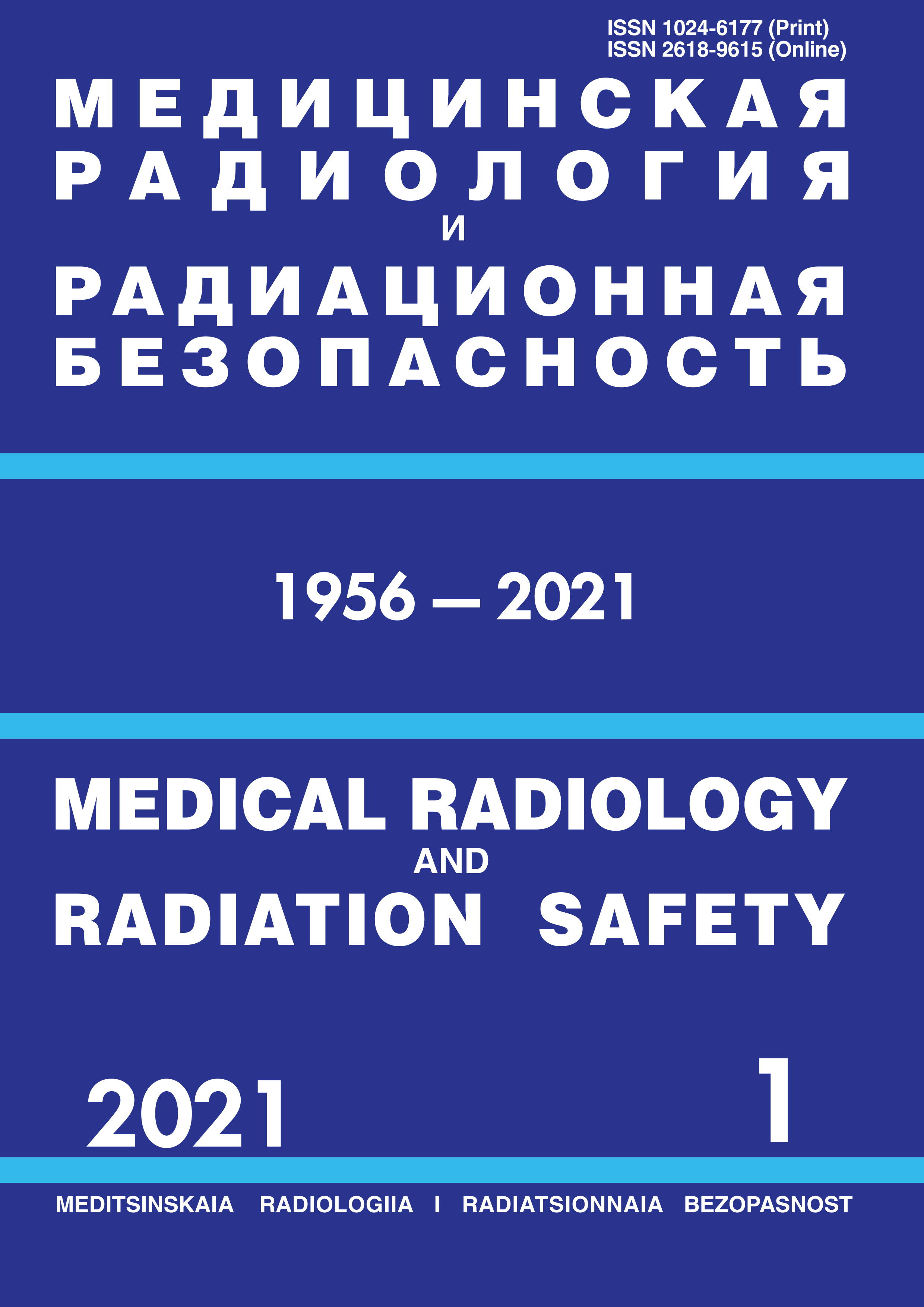Moscow, Russian Federation
Moscow, Russian Federation
Moscow, Russian Federation
Russian Federation
CSCSTI 76.33
CSCSTI 76.03
Russian Classification of Professions by Education 31.06.2001
Russian Classification of Professions by Education 31.08.08
Russian Classification of Professions by Education 32.08.12
Russian Classification of Professions by Education 14.04.02
Russian Library and Bibliographic Classification 534
Russian Library and Bibliographic Classification 51
Russian Trade and Bibliographic Classification 5712
Russian Trade and Bibliographic Classification 5734
Russian Trade and Bibliographic Classification 6212
Russian Trade and Bibliographic Classification 5708
Purpose: To develop a methodology for determining the muscle mass index (MMI) at the level of Th12 based on the computed tomography of the chest; to estimate the impact of MMI on the outcome of the COVID19 patients as a prognostic factor. Material and methods: The medical data and computed tomography of the chest of 247 patients with confirmed pneumonia caused by SARS-Cov2 were used. A technique has been developed for determining MMI based on the cross-sectional area of paraspinal muscles at the level of the Th12 vertebra and the length of the thoracic spine. A correlation analysis of MMI calculated based on the length of the thoracic spine MMI(L) and height MMI(H) was performed. A statistical analysis of the differences of the MMI(L) in the groups of male and female patients with fatal outcome and recovered, as well as younger and older than 65 years were performed. Results: A strong correlation was found between the MMI calculated on the basis of the length of the thoracic spine and height (r = 0.861, p <0.001). The age threshold, which was associated with an increase in the likelihood of death, in men was 60 years (Se 77.3 %, Sp 60.5 %, PPV 51.5 %, NPV 83.1 %, Youden's index 0.378, area under ROC- curve 0.728), in women 65 years old (Se 72.2 %, Sp 68.6 %, PPV 49.1 %, NPV 85.5 %, Youden's index 0.408, the area under the ROC curve 0.734). The odds ratio of death when the age thresholds are exceeded was 5.2 for men (95 % CI: 2.3 – 12.0), for women – 5.7 (95 % CI: 2.4 – 13.4). MMI(L) 3.37cm2/m2 is a threshold value, below which the probability of death in male patients under 60 years increased 26.3 times (95 % CI: 4.8 – 143.0). In female patients, there was no statistically significant threshold value of MMI(L), which would be associated with a higher risk of death. Conclusion: MMI, calculated at the level Th12 on the basis of the length of the thoracic spine, can be reliably used as a tool to estimate sarcopenia associated muscle atrophy, if there is no anthropometric data. The MMI(D) less than 3.37 cm2/m2 is a strong predictor of death in men under 60 years of age. Further work is needed to study the effect of sarcopenia on the severity and outcome of COVID19 in female patients, taking into account comorbid conditions.
computed tomography, sarcopenia, muscle mass index, COVID19, SARS-Cov2, prognostic factors
1. Rafiq D, Batool A, Bazaz MA. Three months of COVID 19: A systematic review and meta-analysis. Reviews in Medical Virology. 2020;30(4). DOIhttps://doi.org/10.1002/rmv.2113
2. Hassan SA, Sheikh FN, Jamal S, Ezeh JK, Akhtar A. Coronavirus (COVID-19): A Review of Clinical Features, Diagnosis, and Treatment. Cureus. 2020;12(3):e7355. Published 2020 Mar 21. DOIhttps://doi.org/10.7759/cureus.7355
3. Ma C, Gu J, Hou P, et al. Incidence, clinical characteristics and prognostic factor of patients with COVID-19: a systematic review and meta-analysis. Published online March 20, 2020. DOIhttps://doi.org/10.1101/2020.03.17.20037572
4. Du R-H, Liang L-R, Yang C-Q, et al. Predictors of mortality for patients with COVID-19 pneumonia caused by SARS-CoV-2: a prospective cohort study. European Respiratory Journal. 2020;55(5):2000524. DOIhttps://doi.org/10.1183/13993003.00524-2020
5. Cruz-Jentoft AJ, Bahat G, Bauer J, et al. Sarcopenia: revised European consensus on definition and diagnosis. Age and Ageing. 2019;48(4):601. DOIhttps://doi.org/10.1093/ageing/afz046
6. Antunes AC, Araújo DA, Veríssimo MT, Amaral TF. Sarcopenia and hospitalisation costs in older adults: a cross-sectional study. Nutr Diet. 2017;74(1):46-50. DOIhttps://doi.org/10.1111/1747-0080.12287
7. Masenko VL, Kokov AN, Grigor'eva II, Krivoshapova KE. Luchevye metody diagnostiki sarkopenii. Issledovaniya i praktika v medicine. 2019;6(4):127. https://DOI.org/https://doi.org/10.17709/2409-2231-2019-6-4-13 [Masenko VL, Kokov AN, Grigoreva II, Krivoshapova KE. Radiology methods of the sarcopenia diagnosis. Research and Practical Medicine Journal. 2019;6(4):127. DOIhttps://doi.org/10.17709/2409-2231-2019-6-4-13]
8. Nemec U, Heidinger B, Sokas C, Chu L, Eisenberg RL. Diagnosing Sarcopenia on Thoracic Computed Tomography. Academic Radiology. 2017;24(9):1154. DOIhttps://doi.org/10.1016/j.acra. 2017.02.008
9. Derstine BA, Holcombe SA, Ross BE, Wang NC, Su GL, Wang SC. Skeletal muscle cutoff values for sarcopenia diagnosis using T10 to L5 measurements in a healthy US population. Sci Rep. 2018;8(1):11369. Published 2018 Jul 27. DOIhttps://doi.org/10.1038/s41598-018-29825-5
10. Nakano A, Ohkubo H, Taniguchi H, et al. Early decrease in erector spinae muscle area and future risk of mortality in idiopathic pulmonary fibrosis. Scientific Reports. 2020;10(1). DOIhttps://doi.org/10.1038/s41598-020-59100-5
11. Komatsu R, Okazaki T, Ebihara S, et al. Aspiration pneumonia induces muscle atrophy in the respiratory, skeletal, and swallowing systems. Journal of Cachexia, Sarcopenia and Muscle. 2018;9(4):643. DOIhttps://doi.org/10.1002/jcsm.12297
12. Elliott JE, Greising SM, Mantilla CB, Sieck GC. Functional impact of sarcopenia in respiratory muscles. Respiratory Physiology & Neurobiology. 2016;226:137. DOI:10.1016 /j.resp. 2015.10.001
13. Peake JM, Della Gatta P, Suzuki K, Nieman DC. Cytokine expression and secretion by skeletal muscle cells: regulatory mechanisms and exercise effects. Exerc Immunol Rev. 2015;21:8-25.





